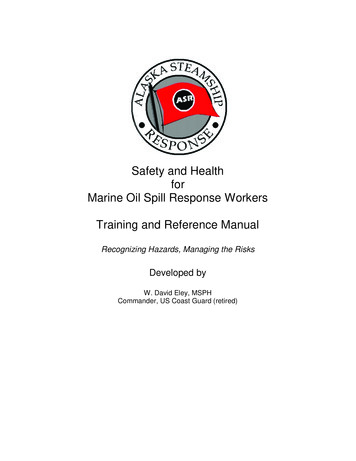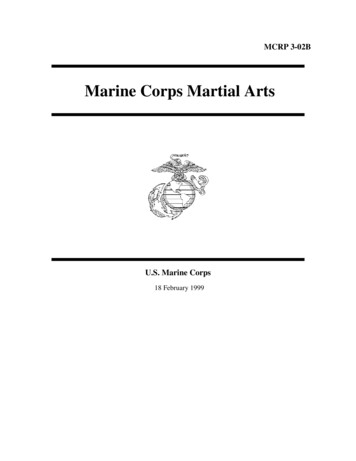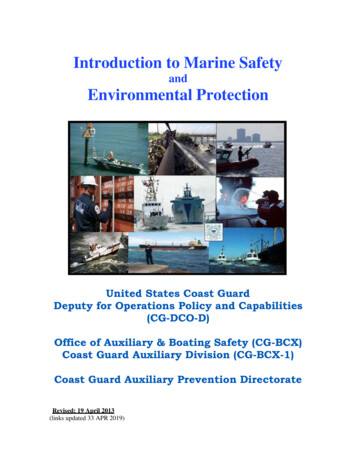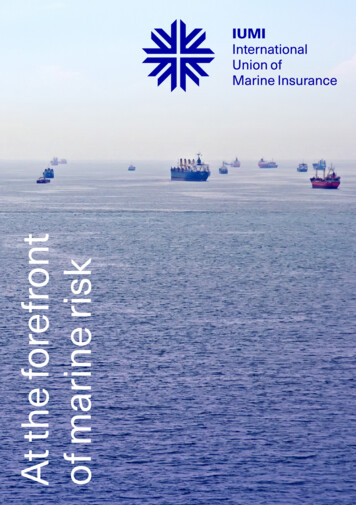
Transcription
Safety and HealthforMarine Oil Spill Response WorkersTraining and Reference ManualRecognizing Hazards, Managing the RisksDeveloped byW. David Eley, MSPHCommander, US Coast Guard (retired)
Safety and Health for Oil Spill Response: Training and Reference Manual (draft)Alaska Steamship ResponseAlaska Steamship Response (ASR) is a non-profit (IRS 501(c)(3)) corporationchartered and registered in the State of Alaska. ASR provides emergency incidentmanagement services, contingency planning, and has been certified by the AlaskaDepartment of Environmental Conservation (ADEC) as both an incidentmanagement team and response plan facilitator under the requirements of AS46.04.055 and 18 AAC 75.400 - 18 AAC 75.496.ASR has approximately forty strategically located responders throughout Alaska,from Dutch Harbor to Ketchikan. These responders, all experienced in Alaska maritime operations, meetADEC standards for incident commanders.About the author and editorDavid Eley is a retired US Coast Guard commander and former Coast Guard Captain of the Port forSoutheast Alaska with over 30 years of experience in marine transportation, emergency management,environmental protection, maritime safety and health, and international affairs. While in the Coast Guardhe served as Incident Commander (IC) and Federal On-Scene Coordinator (FOSC) for a number ofvessel casualties and oil spills. Since retirement from the Coast Guard, Mr. Eley has undertaken anumber of consultative projects in marine transportation emergency planning. His clients include the U.S.National Park Service, the cruise ship industry, Alaska Department of Environmental Conservation, theUS Coast Guard, citizens’ environmental protection advisory groups, and the Alaska Marine HighwaySystem. He currently serves as executive director of Alaska Steamship Response.He has a Master of Science in Public Health (Industrial Hygiene and Environmental Health) from theUniversity of North Carolina. He is a former certified industrial hygienist.2 P ag eAlaska Steamship ResponseDecember 2014
Safety and Health for Oil Spill Response: Training and Reference Manual (draft)ContentsI.Introduction .5A.Using this Manual and Training Aid .5B.References used in this manual .5C.Roles and Competencies for ASR team members .7II.Hazards and risks from marine oil spills .8III.Basic Hazardous Material Terms and How to Use Them .10A.Definition of hazardous substances and wastes .10B.Key conversion measurements .11C.What is oil? .11D.Persistent and Non-persistent Oil.12E.Using Material Safety Data Sheets (MSDS) .12F.How to read the GHS Pictogram .13G.Exercise: Comparing properties of hazardous substances .14IV.Risk Assessment Techniques.16A.Defining Risk .16B.Risk Analysis Worksheet .17C.Equipment Used to Evaluate Risk .17V.Personal Protective Equipment .18A. Selection and Use .18B.C.VI.A.Fire Extinguishers .19Hazards and Risks for PPE .20Safe Control and Containment/Confinement Operations .21Confined Space Entry.21What is a confined space? .21Summary of hazards associated with confined space entry .23Policy for confined space entry .24B.Decontamination .25C.Emergency Response Plans and ICS.28Incident Command System (ICS) .28The ICS Safety Officer .29Site Characterization and Monitoring: .30Developing an ICS Site Safety Plan (HASP) .30Site Safety Enforcement .303 P ag eAlaska Steamship ResponseDecember 2014
Safety and Health for Oil Spill Response: Training and Reference Manual (draft)VII.References .31A.Glossary of Key Terms .31B.GHS Pictogram Terms Defined .33C.Key Reference Sources .37Tab A: MSDS GasolineTab B: MSDS Low Sulfur Diesel (Marine Gas Oil)Tab C: MSDS Intermediate Fuel Oil (Bunkers)Tab D: OSHS 3172, HAZWOPER Training for Marine Oil Spill Response WorkersTab E: Spill Tactics for Alaska Responders (STAR): Safety and Site ControlTab F: USCG Safety Officer’s Job Aid: Appendix H, Site Safety and Health Plan (ICS-208)Tab G: Evaluating Risk: ICS-215a. Example and Instructions4 P ag eAlaska Steamship ResponseDecember 2014
Safety and Health for Oil Spill Response: Training and Reference Manual (draft)I.IntroductionA. Using this Manual and Training AidOil spill responders must have annual refresher training inHazardous Waste Operations and Emergency Response(HAZWOPER). This is a requirement both under US OSHA (29CFR 1910.120) and the Alaska Department of EnvironmentalConservation (ADEC) (18 AAC 75.400 - 18 AAC 75.496.ASR members must recognize andmanage the hazards of uncontrolledoil spills or take defensive, protectiveaction accordingly.This manual isdesigned to helpmeet this annualrecertificationrequirement ANDserve as a keyreference sourceASR Team MemberCompetencies1. Recognize basic hazards andrisks.for an actual response.2. Define and use essentialhazardous material terms.Competencies developed within this training manual include theseven competencies recommended by OSHA for oil spillresponders.3. Use hazard and risk assessmenttechniques including confinedspace entry protocols.In addition, the training materials in this manual will show youthe steps needed to: Complete a risk assessment (ICS form 215A)Complete a site health and safety plan. (ICS form 208)B. References used in this manualThis manual and reference, which was developed specificallyfor ASR incident management team (IMT) members, drawsfrom three key references which are included in this documentas references or annexes. Not included in this manual, butreferenced extensively, is the USCG Incident ManagementHandbook (2014) available on ASR flash drives or at USCGHomeport.4. Select personal protectiveequipment with due regard forthe hazards created by theequipment.5. Outline basic oil spill control andcontainment.6. Implement basicdecontamination procedures.7. Practice safety and health withinthe overall incident action planor emergency response plan.Material Safety Data Sheets (MSDS) for various marine fueloils. MSDS are the starting point in developing any spill response safety plan. Several pages in lengthand in a standard format, they provide all the essential physical, chemical and hazard properties forparticular oils as well as safe handling instructions. This annex includes MSDS the oils carried as fuel onnon-tank vessels heavy and intermediate fuel oils (HFO or IFO), marine gas oil (MGO), and gasoline,which could come from the car deck of a ferry. MSDS’s are in the reference section of this guide.Annex 1:U.S. Department of Labor Occupational Safety and Health Administration OSHA 3172 2001,Training Marine Oil Spill Response Workers under OSHA’s Hazardous Waste Operations and EmergencyResponse Standard. (Unnecessary pages of this booklet have been removed including Appendices A-C.)5 P ag eAlaska Steamship ResponseDecember 2014
Safety and Health for Oil Spill Response: Training and Reference Manual (draft)As the title implies this booklet interprets training requirements for oil spill responders under OSHA’sHazardous Waste Operations and Emergency Response Standard (HAZWOPER) or 29 CFR 1910.120.Annex 2: Spill Tactics for Alaska Responders (STAR Manual). Section B. Tactics, Part 1: SafetyThe Spill Tactics for Alaska Responders (STAR) manual provides standardized oil spill response tacticsspecific to the State of Alaska. The information in this manual bridges the gap between oil spillcontingency planning and response by providing standard tactics and terminology that can be easilytransferred from contingency plan to Incident Action Plan.The STAR Manual was commissioned by ADEC and developed through a cooperative consensus-basedwork group process involving federal and Alaska spill response agencies working with representatives ofoil spill response organizations and contingency plan holders.The STAR manual is organized according to five general categories of oil spill response tactics: Safety,Oil Spill Surveillance and Tracking, Mechanical Response, Non-Mechanical Response, and Logistics.Mechanical Response tactics are subdivided into Containment and Recovery, Sensitive Area Protection,and Primary Storage and Transfer of Recovered Products and Waste. ASR IMT members have theentire STAR manual on their response flash-drive and are encouraged to consult this useful referencetool.Annex 3: USCG Safety Officer’s Job Aid, Appendix H & I – Site Safety and Health PlanRequirements, the ICS-208-CG and the ICS-215aThe USCG has developed a number of comprehensive job aids for Incident Command System (ICS)positions which can be downloaded at ( http://homeport.uscg.mil/ics/ ). Appendix H of the Safety Officer’sjob aid provides complete instructions, with examples, for completing the site safety and health plan (ICS208-CG) and the hazard/risk analysis worksheet (ICS-215a).USCG Incident Management HandbookThe USCG Incident Management Handbook (IMH) 2014 is the primary guide for ASR is developing andrunning an incident management structure. Safety, health and risk management is conducted within thesystem shown in this reference. The USCG IMH can be downloaded at USCG Homeport(http://homeport.uscg.mil/ics/) and should also be in ASR flash drives provided to individual members ofthe IMT.6 P ag eAlaska Steamship ResponseDecember 2014
Safety and Health for Oil Spill Response: Training and Reference Manual (draft)C. Roles and Competencies for ASR team membersASR team members are not expected to do actual ‘hands-on’ oil spill cleanup. That is the role of oil spillcleanup contractors - referred to as Oil Spill Resource Organizations (OSRO’s) by the US Coast Guardand Primary Response Action Contractors (PRAC’s) by the State of Alaska. However, ASR membersmay conduct initial incident size up and therefore must have the ability to recognize the hazards ofuncontrolled oil spills or take defensive, protective action accordingly. ASR team members will berequired to serve in key roles within incident management and therefore must understand hazards andhow to set a management structure in place to control those hazards.Table 4 of Annex 1 (OSHA) list competencies for various positions within a marine oil spill response. AnASR IMT member may serve in one of three roles, each with its prerequisite knowledge, as listed below:INITIATE RESPONSE ONLY Understand the hazards of oil and the risks in a spill.Understand what happens during an emergency involving spilled oil.Recognize the presence of oil or related hazardous materials in an emergency.Identify hazardous substances, if possible (e.g., appearance, smell, monitoring equipment).Understand individual role in employer’s emergency response plan.Recognize when help is needed and when to request assistance from the response team.DEFENSIVE RESPONSE Know basic hazard and risk assessment techniques.Know how to select and use proper personal protective equipment necessary for the firstresponder operation level.Understand basic hazardous materials terms.Know how to perform basic control, containment, and/ or confinement operations within thecapabilities of the resources and available personal protective equipment.Know how to implement basic decontamination procedures.Understand the relevant standard operating and termination procedures.ON-SCENE COORDINATOR (i.e. Incident Commander or Section Chief within the ICS structure) Know and be able to implement the employer’s incident command system.Know how to implement the employer’s emergency response plan.Know and understand the hazards and risks associated with employees working in personalprotective clothing.Know how to implement the local emergency response plan.Know the state emergency response plan and the Federal Regional Response Team.Know and understand the importance of decontamination procedures.Removing redundancies amongst positions provides the following list of required competenciesfor an ASR responder.1. Recognize basic hazards and risks in marine oil spill response including precautions for confinedspace entry.2. Define and use essential hazardous material terms.3. Use hazard and risk assessment techniques.4. Select personal protective equipment with due regard for the hazards created by the equipment.5. Outline basic oil spill control and containment.6. Implement basic decontamination procedures.7. Practice safety and health within the overall incident action plan or emergency response plan.Each of these competencies will be addressed in this reference and training manual.7 P ag eAlaska Steamship ResponseDecember 2014
Safety and Health for Oil Spill Response: Training and Reference Manual (draft)II.Hazards and risks from marine oil spillsIncident management teams and field workers mustanticipate and control exposure to oil spills. Risks can bedivided into two main categories: physical and chemical.Simply put, a physical hazard is an item or situation thatmay cause harm from other than a chemical reaction withyour body. Injuries from machinery, confined space entry(oxygen deprivation), flying particle matter, and fire are allphysical hazards.Situational Awareness: A level ofconsciousness, developed throughtraining and education, which allowsyou to recognize potential hazardsand threats within your environment.The OSHA standard (Annex 1) lists27 different potential physicalhazards in oil spill up operations.TEST YOURSELF. List as manyphysical hazards as you can below.Then check your answers againstthe hazards listed on page 5 ofAnnex 1.Note: Make the effort to list at least20 hazards before you review thelists in Annex 1. This exercise willbuild situational awareness.1132143154165176187198209211022112312248 P ag eAlaska Steamship ResponseDecember 2014
Safety and Health for Oil Spill Response: Training and Reference Manual (draft)In general, chemical hazards are created by materials capable of injuring the body by chemical reaction.Examples of chemical hazards include carbon monoxide exposure (CO interferes with O2 uptake by bloodhemoglobin), or benzene exposure (a gasoline additive that can cause leukemia).The physical property of the hazardous material determines the exposure pathway.List the main exposure pathway(s) for:Carbon monoxide:Coal tar:Lead:Benzene:Exercise: Chemicals in OilTable 1 of OSHA 3172 (Training for Oil Spill Response Workers under HAZWOPER) lists commonchemicals associated with oils and their hazardous effects. Examine this table and answer the followingquestions:1.Which of the listed chemical components can potentially cause cancer?a.b.c.2.Which of the listed chemicals are generated by combustion of oil?a.b.c.d.9 P ag eAlaska Steamship ResponseDecember 2014
Safety and Health for Oil Spill Response: Training and Reference Manual (draft)III.Basic Hazardous Material Terms and How to Use ThemA. Definition of hazardous substances and wastesA glossary of important terms is included in Section IX. A. An overview of key terms is discussed in thissection.The term hazardous substance as defined by OSHA is:" any substance which [through exposure] results or may result in adverse effects on the health orsafety of employees." (29 CFR 1910.120(a)(3)).”EPA has identified four characteristics for hazardous waste. Ignitability: Generally, a liquid with a flash point lessthan 60 C (140 F), or not a liquid but capable,under standard temperature and pressure, ofcausing fire through friction, absorption of moistureor spontaneous chemical changes and, when ignited,burns so vigorously and persistently that it creates ahazard, or an ignitable compressed gas.Corrosivity: Aqueous and has a pH less than orequal to 2 or greater than or equal to 12.5, or a liquidcapable of corroding steel (SAE 1020) at a rategreater than 6.35 mm (0.250 inch) per year at 55 C(130 F).Key TermsAsphyxiantVapor PressureFlash PointLower Explosive LimitVapor DensitySpecific Gravity Reactivity: Generally, a solid waste normallyunstable and readily undergoes violent changePPMwithout detonating, or reacts violently with water orforms toxic or potentially explosive mixtures withExposure limits: STEL, TLV, and PELwater, or is a cyanide or sulfide bearing waste which,when exposed to pH conditions between 2 and 12.5,Carcinogens, mutagens, teratogenscan generate toxic gases, vapors or fumes, or iscapable of detonation or explosive reaction is aforbidden explosive as defined in 49 CFR 173.54, or is a Division 1.1, 1.2 or 1.3 explosive asdefined in 49 CFR 173.50 and 173.53. Toxicity: A waste that contains any number of chemicals in sufficient concentrations to present adanger to human health or the environment.See 40 CFR 261.20 through 261.24 for exact definitions and test methods.10 P a g eAlaska Steamship ResponseDecember 2014
Safety and Health for Oil Spill Response: Training and Reference Manual (draft)B. Key conversion measurementsThe international maritime community uses metric units. United States generally uses units ofthe English measurement system. The table below shows key conversions for various units ofmeasure used in health and safety guidelines. The back cover of the USCG IMH provides auseful conversion table. There are several good smart phone apps, Pascal (Pa)VolumeLengthLiters (l)One meter (m) 100centimeters (cm) 1000millimeters (mm)Milligrams/liter (mg/l)Grams/cubic centimeter(g/cm3)One molecule of hazard permillion (billion) molecules ofwater or airToxic concentrations anddensityParts per million (ppm)Parts per billion (ppm)Conversion factor toEnglish System9/50 C 320 to FahrenheitPa/0.0004 Pounds persquare inch (psi)Liter/3.785 GallonsMeter X 39 inchesCm/2.54 inchesN/AC. What is oil?Crude oil is a complex mixture of anumber of hundreds of differentchemicals, many of which are toxic and/orhighly flammable. Raw or unprocessedcrude oil is not generally useful inindustrial applications and for internalcombustion engines. Instead, thehundreds of different hydrocarboncompounds in crude oil are separatedin a refinery by their boiling points intocomponents which can be used asfuels, lubricants, asphalts, and asfeedstocks in petrochemicalprocesses that manufacture (to namea few) plastics, detergents, solvents,elastomers, and fibers (nylon andpolyesters).11 P a g eAlaska Steamship ResponseDecember 2014
Safety and Health for Oil Spill Response: Training and Reference Manual (draft)D. Persistent and Non-persistent OilGenerally, persistent oils do not dissipate quickly and will therefore pose potential threats to naturalresources when released to the environment. In contrast, when released to the environment, nonpersistent oils will dissipate rapidly through evaporation or dissipation through the water column. Spills ofthese oils rarely allow comprehensive response and cleanup.Federal regulations (33 CFR 155.1020) define these oils asfollows:Non-persistent oils include:Non-persistent or Group I oil means a petroleum-based oil that, at thetime of shipment, consists of hydrocarbon fractions—(1) At least 50% of which by volume, distill at a temperature of340 degrees C (645 degrees F); and(2) At least 95% of which by volume, distill at a temperature of370 degrees C (700 degrees F).Persistent oil means a petroleum based oil that does not meet thedistillation criteria for a non-persistent oil. For the purposes of thissubpart, persistent oils are further classified based on specific gravityas follows:(1) Group II—specific gravity of less than .85.(2) Group III—specific gravity equal to or greater than .85 andless than .95.(3) Group IV—specific gravity equal to or greater than .95 andless than or equal to 1.0.(4) Group V—specific gravity greater than 1.0.Persistent oils include:E. Using Material Safety Data Sheets (MSDS)A Material Safety Data Sheet (MSDS) provides basic information on a material or chemical product. AMSDS describes: The properties and potential hazards of the material,How to use it safely, andWhat to do in an emergency.The MSDS is essential information for workers using a hazardous product under routine conditions andthe key reference document for safety and health plans for spill response and cleanup.The information for most MSDS’ developed today are summarized under an ANSI standard for MSDSpreparation. MSDSs are organized into 16 sections:1. Product and company information2. Hazards identification withpictograms3. Product composition4. First aid measures5. Fire-fighting measures6. Accidental release measures7. Handling and storage8. Exposure controls and personalprotection12 P a g e9. Physical and chemical properties10. Stability and reactivity11. Toxicological information12. Ecological information13. Disposal considerations14. Transport information15. Regulatory information16. Other informationAlaska Steamship ResponseDecember 2014
Safety and Health for Oil Spill Response: Training and Reference Manual (draft)F. How to read the GHS PictogramThe Globally Harmonized System of Classification and Labeling of Chemicals (GHS) is aninternationally agreed-upon system, created by the United Nations.The GHS was designed to replace all the diverse classification systems and present one universalstandard which all countries should follow (however, the GHS is not compulsory under UN law). In thelonger term, the GHS is expected to improve knowledge of the chronic health hazards of chemicals andencourage a move towards the elimination of hazardous chemicals, especially carcinogens, mutagensand reproductive toxins, or their replacement with less hazardous ones. The US Department of Labor(OSHA) provides extensive guidance for the use and implementation of GHS.GHS uses internationally recognized pictograms for the various hazard classes. See the glossary in thereference sections for both the pictograms and defined terms.Most Material Safety Data Sheets (MSDS) now use the GHS including the MSDS’ provided for gasoline,marine gas oil and intermediate fuel oil provided with this manual.13 P a g eAlaska Steamship ResponseDecember 2014
Safety and Health for Oil Spill Response: Training and Reference Manual (draft)G. Exercise: Comparing properties of hazardous substancesExercise: Comparing the physical and chemical properties of oilsUsing the three MSDS’s provided in this manual, enter the property units for each oil and rank or comparethe relative hazard.For each property or characteristic draw a frowny-face next to the oil that is a clearly the most hazardousfor that property.CharacteristicMarine Gas Oil(diesel)Marine Fuel Oil(HFO or IFO)Gasoline3Flammability (NFPA)Carcinogenicity222STEL (lowest valuegiven)Odor Threshold(lower is better)Flash Point5 ppm(H2S)0.1 – 1ppmNO600CLower ExplosiveLimit1.3%Vapor Pressure210 Pa(1.6mm)Heavier than air?(Vapor density) 5Specific gravity ofliquid14 P a g e33 to 40.8Alaska Steamship ResponseDecember 2014
Safety and Health for Oil Spill Response: Training and Reference Manual (draft)From the table above what type of physical and liquid properties are most helpful for initialincident size up?Use the glossary in the reference section to complete the following:Match the description with the type of health hazard.Burns skinA. IrritantCauses cancerB. CorrosiveSkin itchC. Target organGene damage (sperm or egg)D. SensitizerAllergic responseE. CarcinogenLiver damageF. TeratogenFetus damageG. MutagenFreezes skinH. Cryogenic15 P a g eAlaska Steamship ResponseDecember 2014
Safety and Health for Oil Spill Response: Training and Reference Manual (draft)IV.Risk Assessment TechniquesA. Defining RiskRisk is a factor severity (how bad could theinjury be?) and probability of occurrence.Combining the probability of occurrence withseverity, a risk assessment matrix (RAM) likethe one below developed by the InternationalCrisis Management Association can define thelevel of risk.Remember: Always approachUPWIND and UPGRADE wheneverpossible and particularly if doingincident size up.The risks inherent in oil spill response and cleanup are reasonably well understood. There are morephysical hazards than chemical hazards.Hazards for first responders are: Fire and explosion.Over exposure to vapors, fumes and particulatesConfined space entry/rescueFallsDrowningIn general, site safety for prolonged oil spill cleanup should address the risk of: Slips, trips and falls.Heavy equipment operationsWork around deep waterSkin contactInhaling particulate matter under certain situationsSpread of oil and contaminated materialConsider the impact of current and projected weather inassessing risk.In my experience, slips, trips and fallsare the most common cause of injuryduring oil spill response. Lack ofprecaution in confined space entry,however, presents the highest risk offatality.Recognizing and evaluating confined space entry hazards is an essential part of the site health and safetyplan (HASP). Low oxygen and toxic gases can in confined space, under certain conditions, can kill within3-4 minutes upon entry.16 P a g eAlaska Steamship ResponseDecember 2014
Safety and Health for Oil Spill Response: Training and Reference Manual (draft)Always start with a developed site safety plan template, then adjust.B. Risk Analysis WorksheetFor a response that will last more than a few hours, the US Coast Guard has developed an IncidentAction Plan Safety Analysis Worksheet (ICS-215a). This worksheet is to aid the Safety Officer incompleting an operational risk assessment to prioritize hazards and develop appropriate controls. Workassignments are listed along with associated hazards. A calculation is made that determines what level ofrisk each work assignment poses. For those assignments having significant risk, controls are developedfor safeguarding responders. The net risk is evaluated against the gain. The Incident Commander shouldbe alerted to all safety hazards that receive an amber or red GAR rating after controls have beenestablished.The steps for developing an ICS-215a are shown in Tab G, the Safety Officer’s Job Aid for evaluatingrisk.Exercise: Using the example ICS-215a in Tab G, complete a risk evaluation for two of the beach cleanup functions for the M/V New Carissa.C. Equipment Used to Evaluate RiskReview the STAR Manual (Tab E) and list basic equipment used for defining risk.1.2.3.4.5.Quiz:The first piece of analytical equipment that should be used on a spill site to identify potential hazards isthe:A. Oxygen meterB. Combustible gas indicatorC. Colorimetric sampling tubesD. Radiation meterIf you were entering a spill site and your combustible gas indicator read 25% of the L.E.L. you should:A. Proceed with cautionB. Leave the site immediatelyC. Continue with the surveyD. None of the above17 P a g eAlaska Steamship ResponseDecember 2014
Safety and Health for Oil Spill Response: Training and Reference Manual (draft)V.Personal Protective EquipmentA. Selection and UseThe level of protection is determined by site conditions.Review the protective equipment a
The USCG Incident Management Handbook (IMH) 2014 is the primary guide for ASR is developing and running an incident management structure. Safety, health and risk management is conducted within the system shown in this reference. The USCG IMH can be downloaded at USCG Homeport











